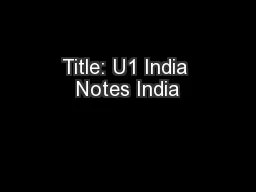

Vedic India Hinduism and the formation of the core Indian culture India Topography Khyber Pass Deccan Plateau Centrally located for trade Indian Ocean amp Silk Road Himalayas insulate India from China ID: 739930
Download Presentation The PPT/PDF document "Title: U1 India Notes India" is the property of its rightful owner. Permission is granted to download and print the materials on this web site for personal, non-commercial use only, and to display it on your personal computer provided you do not modify the materials and that you retain all copyright notices contained in the materials. By downloading content from our website, you accept the terms of this agreement.
Slide1
Title: U1 India NotesSlide2
India
Vedic India, Hinduism, and the formation of the core Indian cultureSlide3
India Topography
Khyber Pass
Deccan PlateauSlide4
Centrally located for trade
Indian Ocean & Silk Road
Himalayas insulate India from ChinaKhyber Pass in Hindu-Kush mountains makes India accessible from Central Asia and West Asia (the Islamic world)The Indus & Ganges River valleys provide fertile lands for population to grow in North
The Deccan Plateau is marked by deep rift valleys, making access to the South difficult (lack of Indian unity)Implications of Indian Geography on the Development of IndiaSlide5
Ancient
Harappan CivilizationSlide6
Harappan
Civilization
2500 – 1600 BCE
Indus River Valley
Dravidian (dark-skinned)
Herded cattle and farmed
Worshipped fertility gods
Icons in the shape of cattle and pregnant women
Ritualized bathing pools
Houses showed evidence
of distinct class divisions
Aryan Migrations
1600 – 1000 BCE
Large, light-skinned
Nomadic horseman from
central Asia (S. Russia)
Brought:
Herding
Oral tradition in SanskritAryan Gods4 Classes
Blend of Dravidian andAryan influences+Called the “Vedic Age”
Classical HinduismBy 500 BCE (start of the Classical Era)Oral traditions written down in the Vedas4 Varnas = Castes and their (Dharma)Brahmin = Priests (learn scriptures)Kshatriyas = Warrior/Aristocrats (govern and fight)Vaishyas = Merchants (to sell goods/work)Shudras = Peasants (to serve)--------------------------------------------------------- UNTOUCHABLESJati = Sub-castes that further divide the varnasSamsara = reincarnation (cyclical existence of the soul)Dharma = dutyKarma = good and bad deedsMoksha = Salvation or release fron the cycle of Samsara
=Slide7
Do the dharma
Of your varnaAnd get good
karmaTo achieve mokshaFrom the cycle of samsara.Free your atmanTo reunite with Brahman.
Know, understand, and use these terms.WTF?! (freak)Slide8
Samsara
BrahmanAtman
KarmaMokshaReview the Upanishads – identify phrases that deal with each concept (quotes that support the idea).Can you find examples of these?dharma
varnaUpanishadsSlide9
MAIN IDEAS of Classical India:
Aryans created many small kingdoms in India that often were at war with each other
The Mauryan Empire founded a centralized state that unified much of India but didn’t last
The Gupta also unified much of India for a short timeIndia lacked a tradition of lasting centralized rule, even after these dynasties existed.Slide10
Economic & Social Developments
Aryans settled, began to farm with metal tools, and civilization grew in Ganges River Valley.
Social hierarchy developed, as the Aryans forced SHUDRAS or “serfs” to work the fields
Towns & trade flourished, causing the further development of the caste system.
Towns & Trade
Manufactured goods for local consumption
Pots, textiles, iron tools, metal utensils
Luxury goods for elites (jewelry, etc.)
Trade flourished
Large factories & marketplaces emerged
Empire built roads to facilitate trade within IndiaSlide11
Long-Distance Trade
Political links with Persia & the Mediterranean (Alexander) established trade with those regions
Silk Road trade to ChinaIndian Exports = cotton, aromatics, black pepper, pearls, gemsImports = horses from west & silk from China
Indian Ocean Sea Routes Increasingly UsedMerchants used Monsoon patterns to get aroundSpring & Summer = from southwestFall & Winter = from northeast
Indian merchants to SE Asia for spicesSlide12
The
Mauryan Empire
Persians and Alexander as evidence of political fragmentation and weakness of India – significance of Alex = political vacuum (may have met / inspired Chandragupta)Mauryan Dynasty (321-185 BCE)
Chandragupta Maurya united northern India in a state via conquest beginning in Magadha (Ganges & Indus River Valleys)Slide13
Ashoka
marked the high point of Mauryan Dynasty (uniting most of southern & northern)
Ashoka ruled via organized bureaucracy Efficient tax collectionStone edictsBuddhist valuesPromoted farming by building irrigation systems
Promoted trade by building roadsAshoka’s policies did not last past his death in 232 BCEAshokaSlide14
A pillar of
Ashoka
Hammurabi’s Code Slide15
Classical India 184 BCE-320 CE
Between
Mauryan & Guptan EmpiresCultural vibrance
despite political decentralizationFlourishing trade (guilds)Thriving religion (Hinduism, Buddhism, Jainism)Recording of Indian epics: Ramayana & Mahabharata (Bhagavad-Gita)
Advances in science & technology
Lesser Dynasties after
Mauryan
Bactrian (Greek) Rule in Northern India (182 BCE – 1 CE)
Kushan
Empire in Northern India (1-300 CE)Slide16
Gupta Dynasty (320 – 550 CE)
Modeled after
Mauryan
EmpireSmaller empire than Mauryan
Less centralized (local regions made many policies and decisions)
Theatre state
Supported sciences (concept of zero and “Arabic” numerals)
Decline in women’s rights (patriarchal dominance,
sati
)
Reemergence of Hinduism and caste
sytemSlide17
White Huns (500 CE +)
Invaded from Central Asia
Left India in a feudal arrangement of local kingsIndia disunified until Mughals in 16th century.
Fall of Classical IndiaSlide18
Title: Mauryan / Gupta Venn Diagram
Create a Venn Diagram for the
Mauryan and Gupta Empires. Label each empire with the appropriate dates.Be sure to include similarities, as well as differences.Include information from ALL themes
.Slide19
Environment – brown/orangeCulture - Yellow
Political – Blue/PurpleSocial – Red/Pink
Economic - GreenThemes: